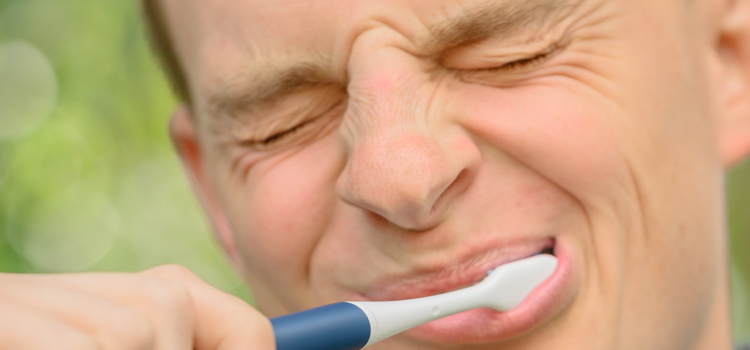What is Dry Socket?

Table of Contents

This blog has been reviewed and approved by Dr Robert Lee, a dental professional of 35 years
LEARN MORE >If you are due to have a tooth removed, your dentist might mention a condition called dry socket. This happens when a blood clot is damaged or doesn’t form correctly as a protective barrier in your mouth after a tooth is removed.
While dry socket is a painful condition, it’s not that common – studies suggest it affects around 1.8% of people after a tooth removal. It can usually be avoided by following your dental professional’s aftercare tips.
In terms of spotting the appearance of dry socket, you may well be able to see visible signs of bone close to your tooth extraction site and get waves of severe pain in the same area.
Causes of Dry Socket
- Bacterial contamination from food or drink after surgery
As food debris gets trapped in the tooth socket and together with oral bacteria, this can cause breakdown of blood clots and interfere with the healing process. That’s why dental professionals will tell you not to eat or drink for a period of time after your tooth removal. - Trauma from brushing or foreign objects
Physically disturbing a blood clot immediately after surgery can lead to its dislodgement and slow your healing process. - Tobacco and nicotine effects
Along with drying out the mouth with smoke, nicotine also decreases the blood supply in your mouth, affecting blood clot formation. - Birth control pills
The high levels of estrogen in oral contraceptives can affect your mouth’s healing process and can cause dry socket for some people.
Dry Socket Symptoms
The signs of dry socket to look out for are a mix of painful sensations that you may feel immediately after surgery and secondary signs to be aware of:
- Blood clot missing from the socket and visible bone within the socket: If a blood clot does not form after your surgery.
- Aching or throbbing pain in a person’s gum or jaw: Three days after a tooth removal, sore feelings should be gone and can be managed with painkillers. A throbbing feeling for longer than this is a telltale symptom of dry socket.
- Unpleasant smell and bad taste coming from the empty socket: Another common sign of dry socket is bad breath and unpleasant taste that lingers in your mouth. If this remains after using an antibacterial rinse (such as a mouthwash) you should see your dental professional straight away.
- Pain that radiates to the rest of a person’s face: Along with a throbbing pain in the area of your operation, another common symptom to tell if you have dry socket is pain that may be felt in your ear, eye, temple or neck.
Dry Socket Treatment
- Cleaning the socket: One of the first dry socket treatments that dentists are likely to offer is cleaning the affected area to remove any food debris and bacteria. This may help to relieve your dry socket pain.
- Medicated dressing: Your dental professional may also apply a medicated dressing to fill the socket once it is cleaned.
- Taking painkillers such as aspirin or ibuprofen: For mild pain, dry socket treatment at home may start with mild pain reliefs or a cold compress to the affected area.
- Prescription pain medication: For persistent and intense dry socket pain, your dental professional may prescribe a more serious pain reliever.
- Oral hygiene: Keep the area clean by rinsing gently with salt water or an antibacterial mouthwash.
How to Prevent Dry Socket
Preventing dry socket may not always be possible but following some simple tips can give you the best chance of a blood clot forming to protect the socket after an extraction and allows it to heal.
- Avoid Straws: If you’re wondering how to prevent dry socket one of the most common answers is to steer clear of any foreign objects that can disturb a blood clot. The force of suction when using a straw may dislodge the clot and cause a dry socket.
- Proper Oral Hygiene: In order to prevent dry socket, your dental professional can advise you on the best oral hygiene routine. Simply rinsing with an antibacterial mouthwash and brushing gently with an electric toothbrush and an antibacterial toothpaste like stannous fluoride once the clot has formed are often recommended.
- Avoid Smoking: Smoking puts you at much higher risk of developing dry socket due to the chemicals found in tobacco products. Additionally, the act of inhaling can often disrupt a blood clot from forming. Dental professionals normally advise to stay clear of consuming nicotine products for about 3 days after extraction.
- Soft Food: Immediately after a tooth extraction you should stick to very soft foods like yogurt and mashed potatoes. As your mouth heals on the second day you can normally return to more solid foods.
FAQs
-
Will dry socket heal on its own?
-
How long before you know you have dry socket?
-
When can I stop worrying about dry socket?
-
How to treat dry socket at home?
Sources
- https://www.webmd.com/oral-health/guide/dry-socket-symptoms-and-treatment
- https://www.healthline.com/health/dental-and-oral-health/dry-socket
- https://www.medicalnewstoday.com/articles/326170
- https://www.mayoclinic.org/diseases-conditions/dry-socket/symptoms-causes/syc-20354376
- https://www.medicinenet.com/dry_socket_overview/article.htm
- http://www.scielo.org.za/pdf/sadj/v71n4/06.pdf
- https://my.clevelandclinic.org/health/diseases/17731-dry-socket
Table of Contents
- Causes of Dry Socket
- Dry Socket Symptoms
- Dry Socket Treatment
- How to Prevent Dry Socket
-
- FAQs
- Sources

This blog has been reviewed and approved by Dr Robert Lee, a dental professional of 35 years
LEARN MORE >
Sign Up
for expert advice and exclusive offers

Sign Up
for expert advice and exclusive offers


